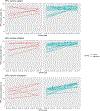Improving adolescent human papillomavirus (HPV) immunization uptake in school-based health centers through awareness campaigns
- PMID: 33640146
- PMCID: PMC8021275
- DOI: 10.1016/j.vaccine.2021.02.006
Improving adolescent human papillomavirus (HPV) immunization uptake in school-based health centers through awareness campaigns
Abstract
Purpose: The aim of this study was to measure the effect of a multicomponent human papillomavirus (HPV) vaccine promotion campaign on adolescent HPV vaccine uptake at school-based health centers (SBHCs) in Seattle, WA.
Methods: Youth-led HPV vaccine promotion campaigns were introduced in 2016 in 13 schools with SBHCs in Seattle. Five other schools with SBHCs served as controls. Vaccination records for students were obtained from the Washington Immunization Information System from September 2012 to August 2018. We compared increase in HPV vaccine uptake in SBHCs between 1) intervention and control schools, and 2) pre- and post-intervention periods in intervention schools using generalized estimating equations.
Results: HPV vaccine uptake was high at baseline among students that use SBHCs for vaccines and has steadily increased between 2012 and 2018. Implementing the promotion campaign resulted in 14% higher (95% Confidence Interval (CI): 1%, 30%) HPV vaccine uptake in intervention SBHCs compared to control SBHCs, adjusting for time and confounders. Comparing pre-and post-intervention periods in intervention SBHCs, HPV vaccine uptake was 14% higher (95% CI: -4%, 35%) in the post-intervention period. SBHCs that received more active intervention activities saw 9% higher (95% CI: 1%, 21%) vaccine uptake compared to those that received passive intervention.
Conclusion: The vaccination promotion program implemented in a school-based setting resulted in higher HPV vaccine uptake in the post-intervention period compared to pre-intervention period, but this increase was not statistically significant. Even so, schools that received more intervention activities for longer periods of time had higher HPV vaccine uptake.
Keywords: Adolescents; Human papillomavirus; Human papillomavirus vaccine; Immunization registry; School-based health centers.
Copyright © 2021 Elsevier Ltd. All rights reserved.
Conflict of interest statement
Declaration of Competing Interest The authors declare that they have no known competing financial interests or personal relationships that could have appeared to influence the work reported in this paper.
Figures


References
-
- Paavonen J, Naud P, Salmeron J, et al. Efficacy of human papillomavirus ( HPV ) −16 / 18 AS04- adjuvanted vaccine against cervical infection and precancer caused by oncogenic HPV types ( PATRICIA ): fi nal analysis of a double-blind, randomised study in young women. Lancet 2009; 374:301–314. - PubMed
-
- Garland S, Hernandez-Avila M, Wheeler CM, et al. Quadrivalent Vaccine against Human Papillomavirus to Prevent Anogenital Diseases. N Engl J Med 2007; 356:1928–1943. - PubMed
Publication types
MeSH terms
Substances
Grants and funding
LinkOut - more resources
Full Text Sources
Other Literature Sources
Medical

